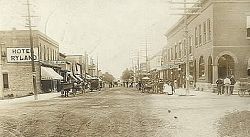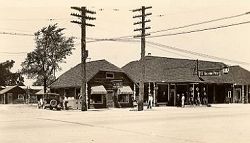Historical Overview
 The City of Standish, situated on the Macinac Division of the M.C.R.R. was first a part of Arenac Township, Bay County, becoming a part of Lincoln Township in 1882. The town was first platted in 1871 by Mr. John D. Standish, who owed all the land in the vicinity. The plat was made by the late P.M. Angus, who came on foot from Whitefeather to do the work, the railroad not having been built as far as Standish at that time. Before the plat was recorded, Mr. Standish had disposed of some of his interests, and the name was changed to Granton and was so recorded. At the next session of the legislature, Mr. Standish succeeded in having the name changed back to “Standish”. The first industry in the place was the saw mill built and operated by Mr. Standish.
The City of Standish, situated on the Macinac Division of the M.C.R.R. was first a part of Arenac Township, Bay County, becoming a part of Lincoln Township in 1882. The town was first platted in 1871 by Mr. John D. Standish, who owed all the land in the vicinity. The plat was made by the late P.M. Angus, who came on foot from Whitefeather to do the work, the railroad not having been built as far as Standish at that time. Before the plat was recorded, Mr. Standish had disposed of some of his interests, and the name was changed to Granton and was so recorded. At the next session of the legislature, Mr. Standish succeeded in having the name changed back to “Standish”. The first industry in the place was the saw mill built and operated by Mr. Standish.
Standish was incorporated as a Village in 1893 and Mr. James E. Austin was elected as its first President. In 1903 it was incorporated as a City. Mr. H. Randall was elected its first Mayor.
 Standish was without a railroad until the early part of 1871, when the Jackson and Lansing road was built, now the Michigan Central. The train at that time ran as far north as Wells Station. The building now used as a freight house and office was the first depot built. This was used as a passenger and freight depot until 1889, when the new stone depot was erected. The grounds surrounding the new depot were cleared and graded by the Business Men’s Association. Previous to the building of the railroad, Standish was reached by stage from Pine River. The first passenger coach to arrive in Standish was attached to a construction train on July 4, 1871.
Standish was without a railroad until the early part of 1871, when the Jackson and Lansing road was built, now the Michigan Central. The train at that time ran as far north as Wells Station. The building now used as a freight house and office was the first depot built. This was used as a passenger and freight depot until 1889, when the new stone depot was erected. The grounds surrounding the new depot were cleared and graded by the Business Men’s Association. Previous to the building of the railroad, Standish was reached by stage from Pine River. The first passenger coach to arrive in Standish was attached to a construction train on July 4, 1871.
The first hotel in the Village was built in 1871 by Sheriff Burmel, of Bay City and named the Standish House and was under the management of William Shillinger. This hotel was afterwards purchased by George W. Shillinger who occupied it until 1881, when he sold it to Jerome B. Davis. It was destroyed by fire in March, 1902.
Excerpt taken from the Arenac County Independent, 1912. By Dr. R. McGurk.
 The town was first platted by John D. Standish, who owned all the land in the vicinity and built a saw mill here.
The town was first platted by John D. Standish, who owned all the land in the vicinity and built a saw mill here.
The town’s first school was built on the same grounds as the current Standish Elementary School.
The town got its first railroad (now Michigan Central).
The town’s first hotel, the Standish House, was built by Sheriff Burmel of Bay City. It was destroyed by fire in March 1902.
 The town became a part of Lincoln Township after it had been a part of Arenac Township in Bay County.
The town became a part of Lincoln Township after it had been a part of Arenac Township in Bay County.
 Arenac County formed by splitting the large County of Bay into smaller parts.
Arenac County formed by splitting the large County of Bay into smaller parts.
The local newspaper, Arenac County Independent, started publication (and is still in publication today).
 The village of Granton changed its name to the village of Standish.
The village of Granton changed its name to the village of Standish.
 The railroad business was growing dramatically, with eight passenger trains running through town daily.
The railroad business was growing dramatically, with eight passenger trains running through town daily.
 The railroad depot building was built by local farmers in a combined effort, with each bringing his own fieldstone to help.
The railroad depot building was built by local farmers in a combined effort, with each bringing his own fieldstone to help.
 Standish was incorporated as a village. James E. Austin was elected as its first president.
Standish was incorporated as a village. James E. Austin was elected as its first president.
 The State Bank of Standish opened (currently Citizens Bank).
The State Bank of Standish opened (currently Citizens Bank).
 Standish was incorporated as a city. H. Randall was elected its first mayor.
Standish was incorporated as a city. H. Randall was elected its first mayor.
 The first automobiles made their way to Standish with a Buick dealership.
The first automobiles made their way to Standish with a Buick dealership.
 Telephone lines had come to Standish in its early days, but by 1911, 180 phones were listed in the phone directory.
Telephone lines had come to Standish in its early days, but by 1911, 180 phones were listed in the phone directory.
 The city got its first commercial electric lights for homes, businesses and streets. Before then, all were run by generators. Power was available from 7 a.m. to midnight.
The city got its first commercial electric lights for homes, businesses and streets. Before then, all were run by generators. Power was available from 7 a.m. to midnight.
 The new parcel post system opened in Standish, replacing dog sled mail routes.
The new parcel post system opened in Standish, replacing dog sled mail routes.
 The original school burned and was replaced by a two-story building at the same location.
The original school burned and was replaced by a two-story building at the same location.
 The first speed limits were set in Standish – 10 mph in town and 15 mph in residential areas.
The first speed limits were set in Standish – 10 mph in town and 15 mph in residential areas.
 The Temple Theater opened, seating 240 people.
The Temple Theater opened, seating 240 people.
 The first gravel road was created from Standish to Pinconning. Until then, roads were dirt and sawdust.
The first gravel road was created from Standish to Pinconning. Until then, roads were dirt and sawdust.
Prohibition went into effect.
 The sheriff confiscated three illegal stills, and the first local arrests were made.
The sheriff confiscated three illegal stills, and the first local arrests were made.
 The city started installing cement sidewalks, replacing wooden planks.
The city started installing cement sidewalks, replacing wooden planks.
 Battery-operated radios came to Standish.
Battery-operated radios came to Standish.
 The city received 24-hour electricity service supplied by Northern Power Company (taken over by Consumers Energy Company in 1934).
The city received 24-hour electricity service supplied by Northern Power Company (taken over by Consumers Energy Company in 1934).
Electric radios arrived in Standish.
 With automobiles starting to take over, four passenger trains were all that were left. (By 1965, all the passenger train service on the railroads was disconnected.)
With automobiles starting to take over, four passenger trains were all that were left. (By 1965, all the passenger train service on the railroads was disconnected.)
 The population of Standish was 913.
The population of Standish was 913.
 The city of Standish received the deed to Woodmere Cemetery as a gift.
The city of Standish received the deed to Woodmere Cemetery as a gift.
 The waste disposal plat was put into operation.
The waste disposal plat was put into operation.
 Water meters were installed in homes using city water, and street name plates were erected.
Water meters were installed in homes using city water, and street name plates were erected.
 On Sept. 22, the charter of the city of Standish was adopted, therefore making Standish a home-rule city.
On Sept. 22, the charter of the city of Standish was adopted, therefore making Standish a home-rule city.
Sources: “Arenac County Independent,” 1912, by Dr. R. McGurk; “The Story of Standish and Its People, 1976,” by Allan McCready; and city of Standish records
